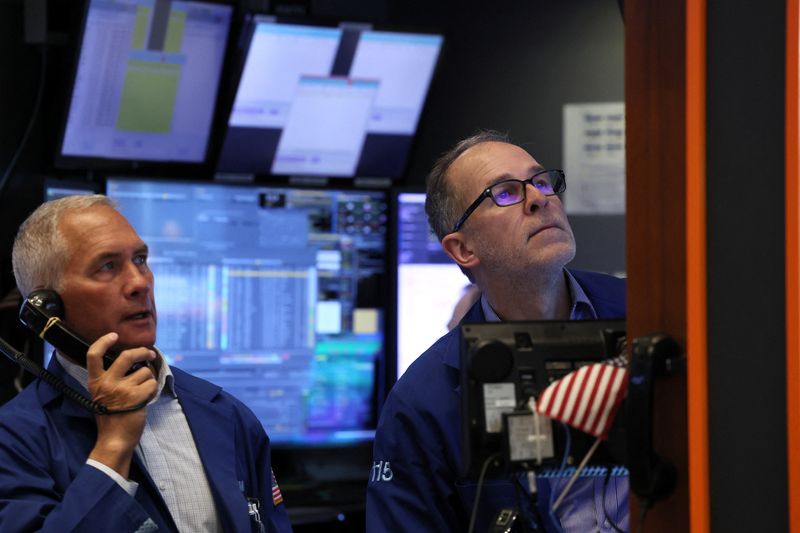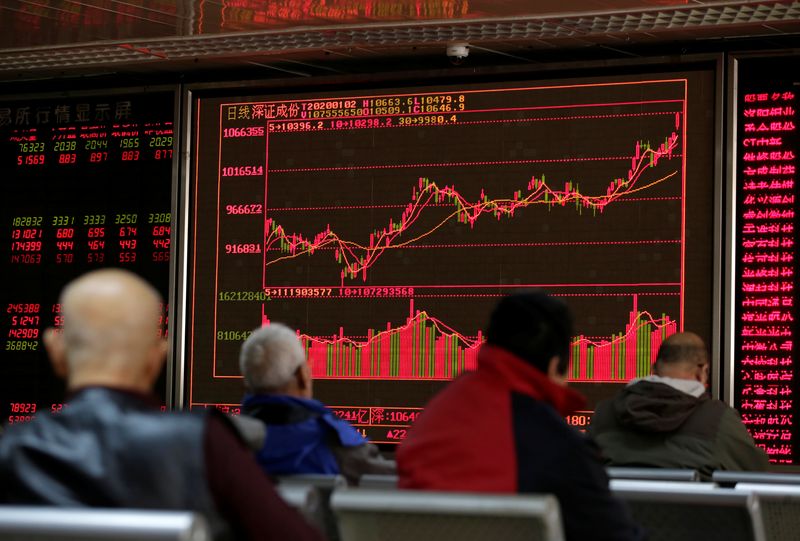By Herbert Lash
NEW YORK (Reuters) -Short-dated Treasury yields rose and a gauge of global equities seesawed near two-year highs on Tuesday after strong U.S. labor market data again underscored a resilient economy and raised questions about how soon the Federal Reserve will cut interest rates.
Gold prices climbed to a two-week high on an easing dollar and lower long-dated Treasury yields as investors awaited the Fed's outlook on rates and the economy when the U.S. central bank concludes on Wednesday its first policy meeting of 2024.
Futures traders sharply raised the likelihood of no rate cut in March to 58.3% from 52.9% on Monday, according to CME Group's (NASDAQ:CME) FedWatch Tool, a reversal from odds of just 11.5% at year-end 2023 that the Fed would keep its target rate at 5.25%-5.50%.
"If you're the Fed and you're faced with this reality of 'OK, labor is still in pretty solid shape,' maybe we don't need to cut straight away. That's what the debate is going to be within the Fed now," said Tom Porcelli, chief U.S. economist at PGIM Fixed Income in Newark, New Jersey.
The two-year Treasury yield, which reflects interest rate expectations, rose 3.3 basis points to 4.355% after a Labor Department report showed U.S. job openings unexpectedly increased in December and the prior month was revised higher. But what caught Porcelli's eyes was the so-called labor market differential in a Conference Board report that is based on respondents' views of whether jobs are plentiful or hard to get, which widened to 35.7 this month from 27.3 in December.
"This labor differential lines up incredibly well with the unemployment rate," Porcelli said. "Not only did it improve a lot, but it improved after what had been a two-year downdraft."
The yield on benchmark 10-year notes rebounded after the jobs data and then slid, down 4.8 basis points at 4.043%.
U.S. stocks were mixed as the solid economic data and its impact on rates, along with concerns about an earnings miss from one of the Magnificent Seven companies - Alphabet (NASDAQ:GOOGL), Amazon (NASDAQ:AMZN), Apple (NASDAQ:AAPL), Meta, Microsoft (NASDAQ:MSFT), NVIDIA (NASDAQ:NVDA) and Tesla - might drive share prices lower.
"The real issue right now is earnings. We're in the heart of earning season and you've got big ones reporting after the close, Google and Microsoft," said Tim Ghriskey, senior portfolio strategist at Ingalls & Snyder in New York.
"There's nervousness out there that one of these companies may miss and that may take down not only that company, but maybe some of the others," Ghriskey added.
MSCI's all-country world index meandered and closed down 0.09%, after earlier in overnight trade hitting a fresh, highest intraday peak since January 2022.
The Dow Jones Industrial Average rose 0.35%, the S&P 500 lost 0.06% and the Nasdaq Composite dropped 0.76%. In Europe, the pan-regional STOXX 600 index closed up 0.16% after earlier touching a fresh two-year high.
Earlier in Asia, regional shares slumped amid deepening worries about the Chinese real-estate sector after China Evergrande was ordered to be liquidated on Monday.
The dollar edged lower against the euro and higher against the yen, but failed to find strong direction ahead of the conclusion of the Fed's policy meeting and Chair Jerome Powell's press conference.
The dollar index, a measure of the U.S. currency against six others, fell 0.05%. The euro rose 0.07% to $1.0841 and the yen weakened 0.06% at 147.61 per dollar.
However, markets remained on edge as tensions in the Middle East kept Brent crude above $80 a barrel
This week's other risk events for investors include the Bank of England's decisions on rates and U.S. employment data for January on Friday.
Oil prices rebounded from earlier losses that were kept in check by supply fears driven by escalating tensions in the Middle East.

U.S. crude futures settled up $1.04 at $7.82 a barrel and Brent rose 47 cents to settle at $82.87 a barrel.
U.S. gold futures settled 0.3% higher at $2,050.90 an ounce.
